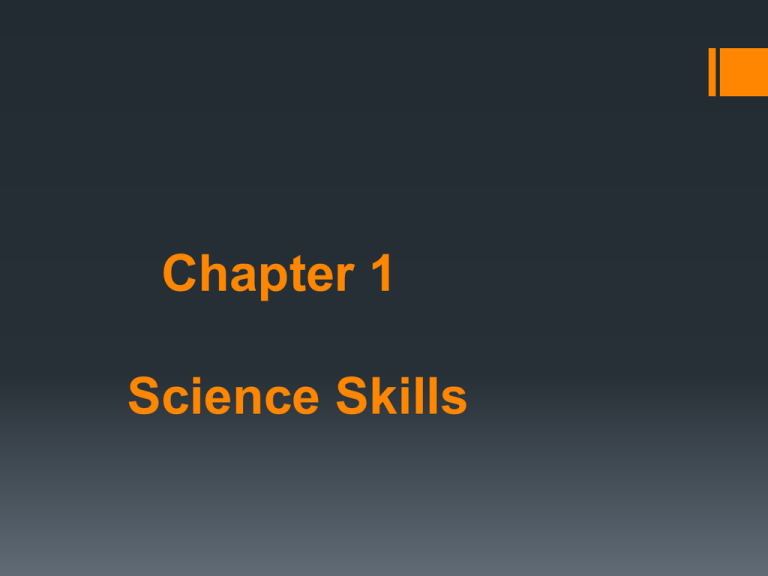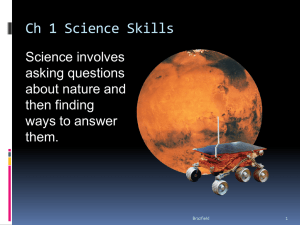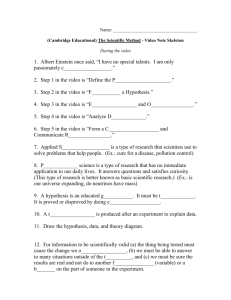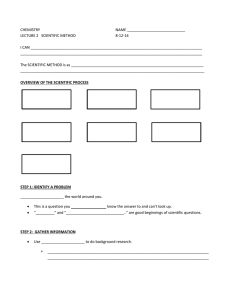Chapter 1 Science Skills
advertisement

Chapter 1 Science Skills 1.1 What is Science? Science is a system of knowledge and the methods you use to find that knowledge The goal of science is to expand knowledge Science often begins with curiosity and often ends with discovery Technology is the use of knowledge to solve practical problems The goal of technology is to apply knowledge Science and technology are interdependent; Advances in one lead to advances in the other 3 branches of science: 1.2 Using a Scientific Approach The scientific method = an organized plan for gathering, organizing, and communicating information Making Observations Scientific investigations often begin with observations. An observation is information that you obtain through your senses. Forming a Hypothesis A hypothesis is a proposed answer to a question. Remember: a hypothesis must be able to be tested! Testing a Hypothesis A variable = any factor that can change in an experiment • The manipulated or independent variable causes a change. • The responding or dependent variable changes in response to the manipulated variable. A controlled experiment is an experiment in which only one variable, the manipulated variable, is changed at a time Drawing Conclusions A conclusion describes how facts apply to a hypothesis. Developing a Theory A scientific theory is a well-tested explanation for a set of observations or experimental results. A model can be made to better understand a hypothesis or theory. They are especially useful for visualizing objects too large or small to be seen easily. After repeated observations or experiments, scientists may arrive at a scientific law. A scientific law is a statement that summarizes a pattern found in nature. • For example, Newton’s law of gravity is a scientific law that has been verified over and over. 1.4 Presenting Scientific Data Scientific data should be organized and clearly communicated. Scientists can organize their data by using data tables and graphs. The simplest way to organize data is to present them in a table. This table relates two variables—a manipulated or independent variable (location) and a responding or dependent variable (average annual precipitation). Which city has the largest average annual precipitation? How might the precipitation in Buffalo differ from the precipitation in Tallahassee? Line Graphs A line graph is useful for showing changes that occur in related variables. • In a line graph, the manipulated variable is generally plotted on the horizontal axis, or xaxis. • The responding variable is plotted on the vertical axis, or y-axis, of the graph. Sometimes the data points in a graph yield a straight line. • The steepness, or slope, of this line is the ratio of a vertical change to the corresponding horizontal change. Plotting the mass of water against the volume of water yields a straight line. What would be the mass of 6 cm3 of water? What is the dependent variable in this situation? How can you tell? This graph shows how the flow rate of a water faucet affects the time required to fill a 1-gallon pot. What is the relationship between flow rate and time according to this graph? How long does it take to fill the pot if the flow rate is 2 gallons per minute? Bar Graphs A bar graph is often used to compare a set of measurements, amounts, or changes. Circle Graphs If you think of a pie cut into pieces, you have a mental model of a circle graph. A circle graph shows how a part or share of something relates to the whole. If you added all the percentages shown what would the total be? Explain. Communicating Data Scientists can communicate results by - writing in scientific journals - speaking at conferences. Scientists also exchange information through conversations, e-mails, and Web sites. Young scientists often present their research at science fairs. 1.3 measurement Scientific notation is a way of expressing a value as a product of a number between 1 and 10 and a power of 10 Ex: 300,000,000 = 3.0 X 108 200 = 2.0 X 102 0.04 = 4.0 X 10-2 0.00086 = 8.6 X 10-4 Scientific notation makes very large or very small numbers easier to work with 100 = 1 101 = 10 102 = 100 103 = 1,000 104 = 10,000 105 = 100,000 106 = 1,000,000 100 = 1 10-1 = 0.1 10-2 = 0.01 10-3 = 0.001 10-4 = 0.0001 10-5 = 0.00001 10-6 = 0.000001 Measurements require a number and a unit Scientists use a set of measuring units called SI = International System of Units The SI system is a revised version of the metric system SI is built upon 7 metric units Ex: length: mass: time: temp.: m kg s K (meter) (kilogram) (second) (Kelvin) Metric prefixes allow for more convenient ways to express SI units Ex: Giga- (G) = 109 = 1,000,000,000 Mega- (M) = 106 = 1,000,000 Kilo- (k) = 103 = 1,000 More prefixes: deci- (d) = 10-1 = 0.1 Centi- (cm) = 10-2 = 0.01 Milli- (m) = 10-3 = 0.001 Micro (m) = 10-6 = 0.000001 Nano (n) = 10-9 = 0.000000001 Limits of measurement: Precision indicates how exact a measurement is Ex: analog clock measures 15 min digital clock measures 14 min and 38 seconds Significant figures are all the digits that are known in an experiment plus the last digit that is estimated The precision of a calculated answer is limited by the least precise measurement used in the calculation Ex: a car travels 68.25 miles in 1.15 hours the average speed was 68.25 / 1.15 = 59.347826087 MPH the answer should only have 3 significant figures 59.3 MPH Accuracy is the closeness of a measurement to the actual value of what is being measured Ex: a clock that is running late is NOT accurate Learning Targets for Chap. 1 1. 2. 3. 4. 5. 6. 7. 8. Identify and describe the 3 main branches of science Contrast science and technology. Describe the steps in the scientific method. Distinguish between a hypothesis, theory and a law Describe the importance of using models. Convert between standard and scientific notation. Explain the importance of the SI system. Use the conversion chart to convert between units in the SI system. 9. Explain the concepts of accuracy and precision 10. Describe when each of the different types of graphs should be used. 11. Be able to construct a quality graph and analyze the data.





